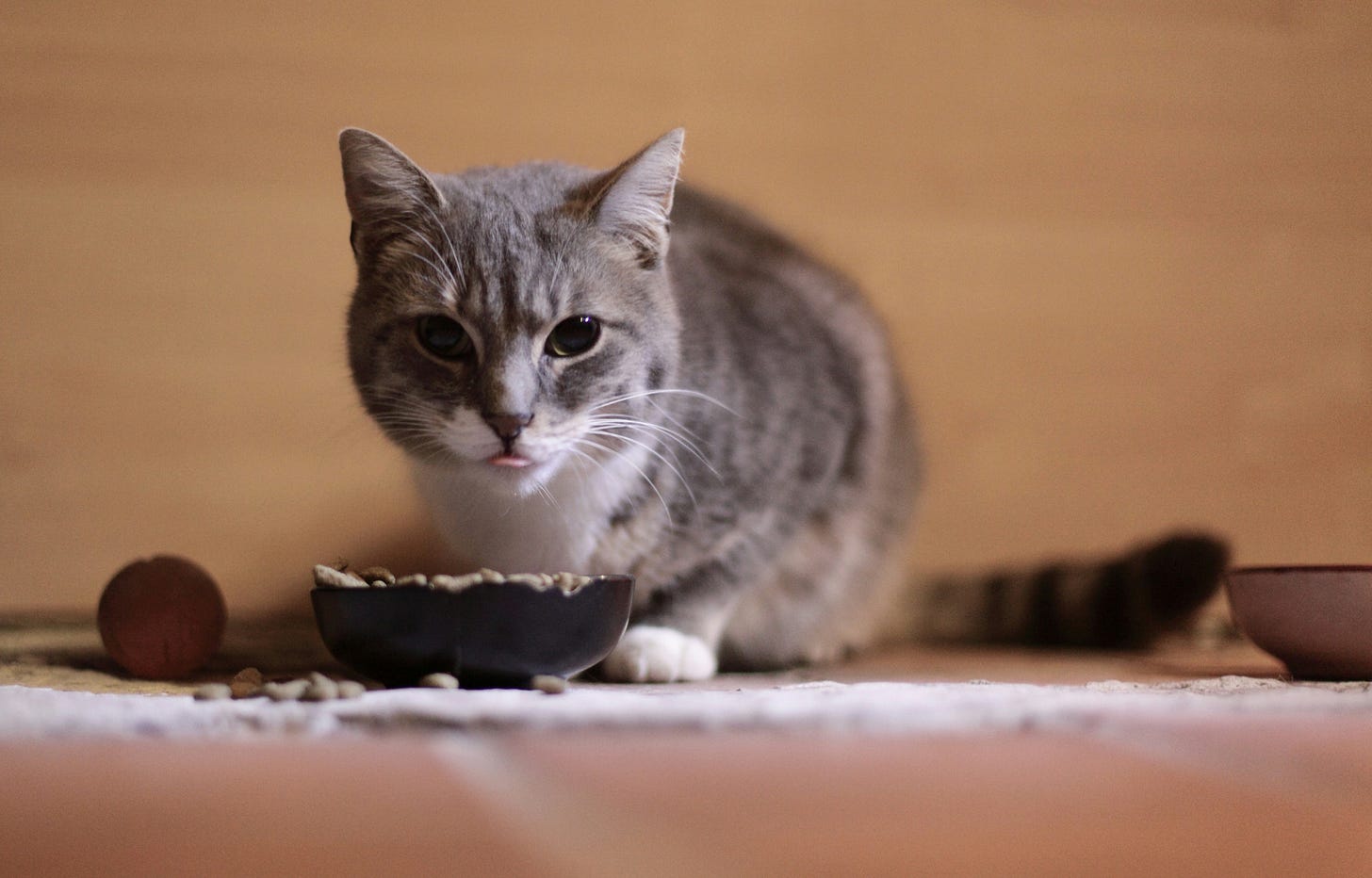The Hidden Truth About Your Cat’s Food (No One Tells You This)
And yes… even the "healthy" brands hide this.
Hey Golden Whiskers family,
There’s a moment I’ve been thinking about this week — a pretty ordinary one, honestly.
I was in my kitchen early one morning, scooping breakfast for Niko and Milo. They were weaving between my legs like they always do, doing their little “hurry up, Dad” routine. And as I set their bowls down, Milo looked up at me with that face he makes — the one that says, “I trust you to get this right.”
It hit me that this is what the whole journey really comes down to.
Our cats don’t read ingredient lists.
They don’t Google reviews.
They don’t worry about formulas or carb content or texture.
They just trust us.
And the weight of that can feel like a lot sometimes — especially when it comes to food.
This week’s podcast grew out of that feeling.
No new guest.
No solo episode.
Just a grounded, practical roundup from three of the smartest nutrition conversations we had during the Feline Wellness Summit.
If you’ve ever wondered whether your cat’s food is really helping them…
or if you’ve ever stood in a pet aisle staring at labels feeling confused…
or if you’ve tried to upgrade your cat’s diet and been met with the “absolutely not” stare…
You’re going to get a ton out of this week’s episode.
Let’s get into it.
🎧 This Week’s Episode: Cat Nutrition Roundup: 3 Experts on Feeding Your Cat Better
✨ Why This Episode Matters
Nutrition is one of those topics that can feel overwhelming really fast. Everyone has an opinion. Every brand has a claim. And the moment you think you’ve got it figured out, something new pops up on TikTok or in a Facebook group.
This episode is designed to help you breathe again.
I pulled clips from three conversations that consistently gave me that feeling of:
Okay… I can actually do this.
You’ll hear from:
Dr. Ruth Roberts — on kibble addiction, slow transitions, and respecting texture
Elizabeth Casas — on label tricks, ingredient splitting, and simple whole-food upgrades
Penny Wood — on hydration, kidney health, and what a species-appropriate diet really looks like
This is a “start where you are” episode.
No pressure.
No judgment.
Just real, practical advice you can use today.
📘 Episode Snapshot
Here’s what you’ll learn in this week’s roundup:
Why kibble is so addictive (yes, it’s by design)
Why cats fight new textures
How to safely transition from kibble → canned → cooked → raw
How to spot marketing tricks on pet food labels
What “meal” and “by-product” actually mean
Why hydration is one of the easiest ways to support kidney health
How to cook for your cat in a crock pot without living in your kitchen
What a “species-appropriate diet” means in real life — not theory
And why even one small upgrade can make a long-term difference
This isn’t about perfection.
It’s about giving your cat a healthier bowl… one doable step at a time.
🐾 Expert Recommendations for Cat Parents
(A blend of the best insights from Dr. Ruth, Elizabeth, and Penny)
1. Think in baby steps — even an eighth of a teaspoon matters.
Dr. Ruth talked about moving her cat from kibble → canned → cooked over months.
The trick?
Start with 1/8 teaspoon of the new food next to the original bowl.
No mixing.
No pressure.
Just familiarity.
2. Kibble → wet is often the biggest upgrade you can make.
If your cat eats kibble now, Elizabeth recommends shifting to wet or canned first.
More moisture, fewer carbs, less processing.
Huge win.
3. Watch out for ingredient splitting.
Corn flour + corn gluten + ground corn = still corn.
If you see the same thing listed three ways… the company is hiding it.
4. A crock pot can change everything.
Elizabeth lays out exactly how to batch a big pot of lightly-cooked cat food overnight.
For cats (who eat tiny portions), this can last weeks and cost less than “premium” kibble.
5. Hydration might be the biggest longevity hack.
Penny reminds us: cats are terrible free drinkers.
Adding moisture — through food, bone broth, kefir water, or fountains — can take stress off the kidneys and support a healthier, longer life.
6. Species-appropriate doesn’t have to be all-or-nothing.
Raw, cooked, freeze-dried, wet…
Even mixing formats is better than staying fully kibble.
Pick one upgrade and start there.
😺 What I’m Trying With Niko and Milo
This episode reminded me to experiment a little more — in a gentle, slow way.
Here’s what I’m testing this week:
1. Texture Play
Since they’re still young and pretty open to new things, I’m trying one new texture every few days — a small amount of lightly cooked turkey, a freeze-dried topper, or a sliver of sardine.
2. More hydration variety
Both boys love their fountain, so I’m adding a little bone broth a couple times a week to encourage even more moisture.
3. Micro-upgrades
Borrowing Dr. Ruth’s idea, I’m starting super small with anything new… no rush, no pressure. Just curiosity.
I want Niko and Milo to grow up with food confidence — not food stress.
This feels like a good path.
🐾 This Week’s Cattitude Prompt
What’s one small, doable upgrade you could make to your cat’s bowl this week?
Not perfection.
Just… something slightly better than yesterday.
Write it down.
Try it.
See how your cat responds.
🎧 Listen to This Week’s Episode
Cat Nutrition Roundup: 3 Experts on Feeding Your Cat Better
👉 Listen here.
Whether your cat eats kibble, canned, raw, lightly cooked, or a mix… this one is worth a listen.
Give your cat a little extra love from me, Niko, and Milo.
I’ll see you next Sunday.
— Scott



